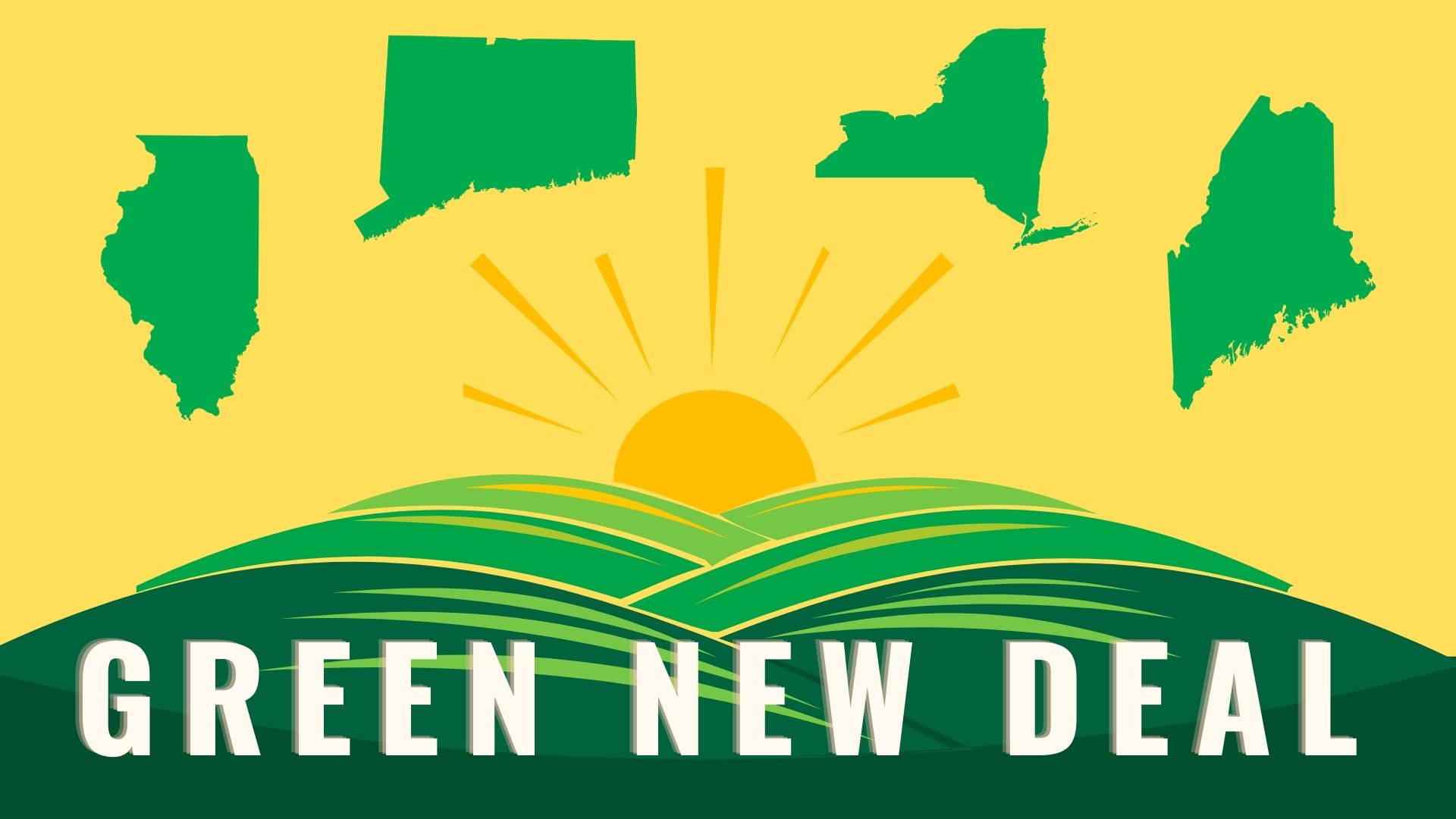Workers and unions are among those who have the most to gain by climate protection that produces good jobs and greater equality. That’s why unions in the most diverse industries and occupations are creating their own Green New Deal-type programs in localities around the country. Here are some examples:
A Green New Deal for Somerville
Brian Doherty at SST unity breakfast. Author: Rand Wilson
Somerville, MA is an inner suburb of Boston and the most densely populated city in New England with 81,000 residents. It was long an industrial center inhabited by repeated waves of immigrants, but it has increasingly become a bedroom community for Boston and Cambridge.
Somerville is currently being transformed by the extension of the Boston Metropolitan Transit Authority (MTA) subway system’s Green Line throughout the city, bringing transit access to 80% of Somerville residents. Over five million square feet of new development is in the works.[1]
Somerville’s long-term mayor supported development but not union labor for either city employees or for construction, much of which, to the dismay of building trades unions, was done non-union. In 2017, Bernie Sanders’ supporters in Our Revolution Somerville won a progressive majority on the board of aldermen (now City Council). Seeing a shift in the political winds, the head of the greater Boston building trades, Brian Doherty, and other union leaders, decided the time was ripe to establish a community-labor coalition to demand a new orientation for development. According to Doherty,
What we’ve experienced in Somerville is income inequality in real time. Developers coming into this city to our back yard, where our friends and families live, exploiting it to make as much money as they can to fill the coffers of rich people. Developers come into our town and say, we need breaks. We need to undermine workers’ rights. We need to undermine environmental protections. We can’t do affordable housing. People who care about environmental justice, housing stability, workers’ rights and giving people a fair day’s pay for a fair day’s work: We have to stand up collectively as partners.[2]
The building trades partnered with Our Revolution Somerville for a breakfast kickoff on December 16, 2017 where coalition leaders met with the city council to describe their respective issues. Early participants included:
- AFSCME Local 274
- Building and Construction Trades Council of the Metropolitan District
- Community Labor United
- Firefighters Local 76
- Good Jobs Somerville
- Good Jobs, Strong Communities Coalition
- IUPAT DC 35
- Greater Boston Labor Council
- MassCOSH
- Mass Senior Action Council – Cambridge/Somerville
- New England Joint Board UNITE HERE
- New England Regional Council of Carpenters
- Our Revolution – Somerville
- Teamsters Local 122
- Somerville Municipal Employees Association
- SEIU Fireman & Oilers Local 3
- SEIU Local 509
- SEIU Local 888
- Teamsters Local 25
- The Welcome Project – Somerville[3]
The first focus of the newly formed Somerville Stands Together (SST) coalition was a $2 billion project being developed in Union Square in anticipation of the subway expansion. The coalition, backed by unions of municipal workers, firefighters, hotel and restaurant workers, and by immigrant organizers, mobilized for a project labor agreement (PLA) that would provide union conditions for Union Square construction and operation. Meanwhile, a neighborhood organization, Union United, anchored by organizers from the Somerville Community Corporation (SCC), successfully campaigned for a community benefits agreement with the developer, USQ. While SST did not win a project labor agreement, labor rights and local hire language was included in the community benefits agreement. Contractors are to use their “best efforts” to ensure that “at least 20% of its workforce are qualified Somerville residents; 20% of its workforce are qualified minorities; and 8% of its workforce are qualified women.”[4]
Initially there were no environmental groups in SST. But in 2018 some activists in 350MA and the Climate Coalition of Somerville decided to reach out to community and labor constituencies and started attending SST’s monthly meetings. They were welcomed and began occasionally pointing out ways that SST programs might be mutually reinforcing with climate and environmental objectives. An SST leader pointed out that “this all ties together.” The head of the municipal workers union hosted a local cable TV show on labor, climate, and the Green New Deal with Joe Uehlein of the Labor Network for Sustainability, which led to the holding of a Labor-Climate Summit in September, 2020.
The City of Somerville had established its “Somerville Climate Forward” action plan in 2018. It presented a comprehensive set of programs for climate protection, but it had two limitations. It called for the city to become carbon-neutral, but it had only a 2050 target, no interim targets, and no way to implement or enforce compliance. And it did little to address labor or justice concerns. An SST working group met through the spring and summer of 2021, dissected the plan, and developed a revision dubbed the “Somerville Climate Further Forward Plan.” It moved up the target for carbon neutrality from 2050 to 2035; established interim benchmarks; delineated labor standards; and incorporated plans to meet equity goals. It called for economic development “to not only achieve climate mitigation and adaptation goals, but also to create jobs with prevailing wages and benefits for all workers, create a public transportation system that benefits lower income neighborhoods, and build and upgrade housing for all community residents.”[5]
In anticipation of the bipartisan American Rescue Plan Act (ARPA) and American Infrastructure and Jobs Act, a second SST working group developed a program for “shovel-ready” projects for federal funding that would meet SST’s goals. The working groups developed a Somerville Green New Deal statement that set out four goals for the city:
- Increase economic, social, and racial equity;
- Target projects to meet city carbon neutrality by 2035;
- Adopt model project labor standards; and
- Build Workforce of the Future.[6]
In August 2021, SST gave a PowerPoint presentation of their work at two pre-election forums. All candidates for mayor and for city council attended the forums – and all endorsed the SST proposals. The mayor who was elected had worked with SST on the Climate Further Forward plan.
Nearly $72 million is now on its way to Somerville under the American Rescue Plan (ARPA). A substantially larger pot of money will be coming under the federal Infrastructure and Jobs Act, and more is expected from state programs as well. A city committee that is determining ARPA allocations has set aside $18 million for projects proposed by community groups. SST has asked that its role should not be proposing particular projects but advising on how to make the process inclusive and make sure that it addresses Green New Deal goals.
SST leaders say they have achieved a coalition perspective, with labor, community, and climate organizations joined together around what have become common concerns. Despite their successes, they are well aware that realizing their goals will take many more struggles. They are currently developing their next set of objectives and campaigns. The new climate benchmarks need to be incorporated into city plans. SST has a “local hire” committee working to make sure the local hire language in the Union Square Community Benefits Agreement gets implemented. It recently ran a community seminar on CBAs in preparation for upcoming campaigns for CBAs for the many new development projects springing up around the Green Line. More broadly, Somerville’s Green New Deal advocates say the city needs to implement a new approach to development, one that requires union labor and prioritizes women and people of color.
SST aims for nothing less than what it calls a “Green New Deal for Somerville.” It sees an opportunity to realize several essential goals at the same time.
We can renew the city’s built environment in a way that forsakes dependence on fossil fuels that damage the environment to reliance on renewable energy sources that save the environment. And doing this will create many new, well-paying jobs, that can raise the living standards of all the city’s residents, and promote social, economic and racial equality. The city can become a model of a local Green New Deal, that can be emulated by other cities across the state and the country.[7]
Unions Reshaping States for Climate, Jobs, and Justice
 State governments have been a major focus of union action for Green New Deal-type programs. States where labor and allies have won major labor-climate legislation in 2021 include the following:
State governments have been a major focus of union action for Green New Deal-type programs. States where labor and allies have won major labor-climate legislation in 2021 include the following:
 Illinois:
Illinois:
In mid-September 2021, Illinois passed the Climate and Equitable Jobs Act—a law to move the state to 100% clean energy by 2050 while creating thousands of new clean energy jobs. The legislation is the product of a multi-year effort and months of negotiations between the environmental/climate/faith/environmental justice-based Clean Energy Jobs Coalition, the renewable developers’ Path to 100 Coalition, and the newly formed labor coalition Climate Jobs Illinois.
Climate Jobs Illinois represents much of the Illinois labor movement. Its executive committee includes Chicago Regional Council of Carpenters, Illinois Education Association, Illinois Federation of Teachers, International Association of Bridge, Structural, Ornamental and Reinforcing Iron Workers Union, the International Association of Heat and Frost Insulators and Allied Workers, International Brotherhood of Electrical Workers (IBEW) State Council, IBEW Local 134, International Union of Operating Engineers Local 150, Laborers International Union of North America Great Lakes Region, Laborers International Union of North America Midwest Region, Service Employees International Union State Council and United Auto Workers Region 4.
The new law will set the state on a path to a carbon-free power sector by 2045. The bill will slash emissions, create thousands of new clean energy union jobs, expand union apprenticeships for Black and Latinx communities, increase energy efficiency for public schools, and safeguard thousands of union workers at the state’s nuclear plants. It also contains a transition program for families and communities currently reliant on jobs in the fossil fuel industry.
According to Climate Jobs Illinois, the law “sets the strongest clean energy labor standards in the country” and “promises to raise the bar for other states seeking to enact new labor and employment policies for building and maintaining clean energy developments.” Pat Devaney, secretary-treasurer of the Illinois AFL-CIO, said,
We have a lot of jobs in the energy sector and particularly in fossil fuel generation, so for us to come forward with a proactive plan [for transitioning] from fossil generation to clean energy, I think, really says a lot about labor’s commitment to combating climate change.[8]
 Connecticut:
Connecticut:
The Illinois union role in fighting for an energy transition that protects the climate, jobs, and justice was by no means unique. In Connecticut, for example, unions and environmental groups organized in 2021 to pass strong labor and equity standards for renewable energy projects through the state legislature. According to the bill’s promoter, the Connecticut Roundtable on Climate and Jobs, an alliance of labor, community, environmental, religious, and social justice groups dedicated to combating climate change, creating jobs, and promote racial, economic, and environmental justice, the legislation will contribute to:
Workforce Development: help working-class families in Connecticut access clean technology careers by requiring developers to partner with approved in-state apprenticeship and pre-apprenticeship programs. Currently, renewable energy developers regularly hire out-of-state workers.
Prevailing Wage: prevent state procurements and other large state-funded projects from driving down the market value of labor. Prevailing wage will be required for utility-scale or grid-connected projects that are assisted by the state (excludes residential installations).
Community Benefits Agreement: ensure that host communities of renewable energy projects receive real benefits from renewable energy projects by requiring developers to negotiate community benefits agreements. This codifies the industry best practice for community outreach.[9]
 New York:
New York:
Unions and allies were prime movers for the 2018 Climate Leadership and Community Protection Act. It required 100 percent carbon-free electricity by 2040 and economy-wide, net-zero carbon emissions by 2050. It called for disadvantaged communities to receive forty percent of overall benefits of spending on clean energy and energy efficiency programs, projects or investments in the areas of housing, workforce development, pollution reduction, low income energy assistance, energy, transportation and economic development.[10] Following on from this legislation, in its 2021 budget New York State included new renewable energy job standards. They require prevailing wage and project labor agreements for construction on renewable-energy projects and labor peace agreements for operations and maintenance work.[11]
 Maine:
Maine:
Unions pushed Maine lawmakers to require a project labor agreement on the state’s first offshore wind project, which means that the Mainers constructing massive turbines to supply clean energy throughout the state will be paid family-sustaining wages with strong labor protections. Now a dozen unions and labor federations have organized the Maine Labor Climate Council. It seeks to
develop the labor movement’s vision for how to tackle the twin crises of climate change and inequality in a way that creates good Maine union jobs, reduces carbon emissions and economic inequality, and provides a seat at the table for workers and unions in this process.
The new Council issued a report spelling out how to implement these objectives. It proposes to electrify all state and local vehicles, including school and city buses, by 2040; build a high speed rail corridor from Bangor to Boston while connecting to Lewiston/Auburn; do deep energy-efficiency retrofits and install solar on all K-12 public schools and publicly owned buildings by 2035; and install 3GW of renewable energy by 2030 and upgrading Maine’s energy transmission and storage capacity.[12]
It is promoting further legislation “to reduce carbon emissions, tackle racial and economic inequality, and create good union jobs.”[13]
Unions and their allies are pushing similar legislation for climate, jobs, and justice in many other states as well.
On Many Fronts
These examples only scratch the surface of union involvement with Green New Deals from below. Here are a few more:
Loggers preserving the forest: In the 1980s and 1990s the International Woodworkers Association, representing woodworking and forestry workers, fought a contentious battle with environmentalists over logging in the Pacific Northwest. But the union, now the Woodworkers Department of the International Association of Machinists and Aerospace Workers (IAM), has switched to promoting forest preservation as a key element of sustainable jobs as well as climate protection.[14]
A union creating a “climate justice agenda” for its employer: Can unions develop and push plans for making their employers climate-safe? The CUNY Professional Staff Congress – the American Federation of Teachers local 2334 — represents the 30,000 full- and part-time faculty and professional staff at the City University of New York. In December 2021, 150 members met to develop a “Climate Justice Agenda for CUNY.” The conference was organized by the union’s Environmental Justice Working Group, which started in 2016 and has been active in City- and State-wide climate coalitions. The conference discussed climate protection demands for the university, including transformation of the food service, environmental education across the curriculum, community collaborations, infrastructure improvements, and divestment of university funds from fossil fuel holdings. The Professional Staff Congress is now campaigning for these objectives both on individual campuses and CUNY-wide.[15]
Electrical workers transforming their industry: IBEW Local 11 and the Los Angeles Chapter of the National Electrical Contractors Partnership established and maintain a Net Zero Plus Electrical Training Institute (NZP ETI), which, when it was built, was the country’s largest Net Zero Plus commercial retrofit, generating more energy than its own annual energy demand. The project unites energy efficiency practices, new clean-energy technologies, improved grid resiliency, and career development. The NZP ETI building – and its training – include such energy efficiency measures as electrical vehicle charging, HVAC, battery storage, microgrids, energy dashboards, lighting, and exterior shading. The program aims to “transform commercial markets by employing the newest electrical technologies and training the most skilled workforce in the United States.”[16]
Cleaning up the L.A. port: An alliance of unions, environmentalists, and community groups supported by the Teamsters’ successfully combatted severe pollution in the Port of Los Angeles. The alliance developed a plan to restructure work relations in the port to provide the self-employed, largely immigrant Latino truck drivers regular jobs with employers who would be responsible for providing low-emission trucks. Their plan for decasualizing the workforce was going forward until a court ruled that the workers were independent contractors and therefore not eligible for union representation. Workers responded with a series of strikes and a subsequent court decision found that the drivers are workers whose labor rights must be respected.[17] While a high proportion of drivers continue to be misclassified as independent contractors, State Senate Bill 388, which went into effect January 1, 2022, will penalize cargo owners who use companies with drivers who aren’t employees.[18]
There are scores of other examples. A September 2021 study by the Center for American Progress listed dozens of Green New Deal programs promoted by unions at state and local levels.[19] The National Nurses United is campaigning for climate-safe hospitals – it has also provided medical care for many climate demonstrators brutalized by violent opponents. The AFT and NEA have worked with construction unions to campaign for green, carbon-free schools. SEIU property management local 32BJ in the New York metropolitan area runs a “Green Supers Program” to provide a professional building service workforce capable of reducing energy use, conserving water, saving money, and providing cleaner and healthier buildings to live in.[20] The United Association (UA), Steelworkers (USW), and other unions are conducting extensive training for workers in the wind power industry. The Utility Workers Union is campaigning and training for reconstruction and public ownership of the electoral grid.[21]
Dig Where You Stand

In this and the previous commentary we have seen the wide range of actions by unions to create jobs and secure justice by fighting climate change. Whether or not they call them the “Green New Deal,” they embody the Green New Deal’s fundamental principles. The unions and workers involved range across the entire workforce. In these commentaries we have seen:
- electrical workers in San Diego creating solar and wind energy installations,
- electric vehicle charging stations,
- training programs for young workers.
- Members of the Laborers’ union building windmills, light rail public transit, solar power plants, and public housing energy efficiency retrofits in locations around the country.
- Minneapolis janitors striking for a green training fund.
- A labor-climate-community coalition initiated by the building trades in Massachusetts winning federal funding for what they call the Somerville Green New Deal.
- Union-led coalitions in Illinois, Connecticut, New York, and Maine reshaping the laws and policies of their states to create jobs and equality by moving to climate-safe energy.
The occupations involved run from loggers to professors and from port truck drivers to nurses. The initiatives range from local and single-employer projects to programs for multi-state regions.
Workers are critical to fixing our economy because they have the skills and knowledge to actually create the Green New Deal. They are already showing that we can start achieving GND goals from climate-safe energy to good jobs to a more equal society right now. And they represent an organized force that can press for the interests of ordinary people in both the economic and the political arena.
As good jobs become harder to find, as inequality and injustice fester, and as the climate crisis becomes ever more destructive, our national government is allowing these threats to working people to escalate. Workers are themselves creating a Green New Deal because workers need a Green New Deal for survival and a decent future.
Workers are showing that they don’t have to wait to start addressing the problems we face. Unions, labor councils, and other worker organizations can start addressing them right now – in fact, they are already doing so. The next step could be to recognize – and celebrate – this growing wave of constructive activity. To start sharing with each other what workers are doing and what we can learn from it. And ultimately to combine them to create labor’s own Green New Deal from Below.
[1] Catherine Carlock, “The Green Line is coming to Somerville. Big changes are coming too.” Boston Globe, March 2, 2022. https://www.bostonglobe.com/2022/03/02/business/green-line-is-coming-somerville-big-changes-are-coming-too/
[2] Based on “Remarks of Brian Doherty at Summerville Stands Together Unity Breakfast,” December 20, 2021. https://www.youtube.com/watch?v=U5NN-xKdMLQ
[3] “Somerville Stands Together,” https://somervillestandstogether.com For more on the origins of SST, see Jim Clark, “Coalition calls on city to support good jobs, affordable housing, contracts,” The Somerville Times, May 2, 2018 https://www.thesomervilletimes.com/archives/83486 and “Somerville Stands Together for good jobs, affordable housing,” The Somerville Times, July 25, 2018 https://www.thesomervilletimes.com/archives/85387
[4] “USNC Community Benefits Agreement Term Sheet,” Union Square Neighborhood Council, August 13, 2019. http://unionsquareneighborhoodcouncil.org/images/docs/190825-US2%20-%20Letter%20to%20USNC%20Negotiating%20Committee%20re%20CBA%20Term%20Sheet.pdf
[5] “Somerville Climate Forward; Somerville’s Community Climate Change Plan,” Somerville Stands Together, June 21, 2021. https://www.somervillema.gov/departments/programs/somerville-climate-forward
[6] “A Green New Deal for Somerville – Getting the City ‘Shovel Ready’ for State and Federal Support to Meet Climate and Equity Goals. A Position Statement of Somerville Stands Together,” June 2021.
[7] “A Green New Deal for Somerville – Getting the City ‘Shovel Ready’ for State and Federal Support to Meet Climate and Equity Goals. A Position Statement of Somerville Stands Together.” June 2021.
[8] Michael Sainato, “Labor and Environmental Movements Team Up and Win Big in Illinois,” The Real News, September 28, 2021. https://therealnews.com/labor-and-environmentalist-movements-team-up-and-win-big-in-illinois%EF%BB%BF For more on the Illinois legislation see “Labor and Environmentalist Movements Team Up and Win Big in Illinois,” The Real News; “Climate Jobs Illinois Applauds Senate Passage of Clean Energy Legislation to Create Thousands of Union Jobs, put State on Path to be 100% Carbon Free by 2045”; “Illinois now boasts the ‘most equitable’ climate law in America. What will that mean?” Chicago Sun Times; “Illinois Just Won a Big Green Jobs Victory,” Jacobin; text of bill: “Climate and Equitable Jobs Act (SB2408).
[9] “Senate Bill 999: The Climate and Community Investment Act!” Connecticut Roundtable on Climate and Jobs. https://ctclimateandjobs.org/campaigns/sb999/
[10] David Roberts, “New York just passed the most ambitious climate target in the country,” Vox, July 22, 2019. https://www.vox.com/energy-and-environment/2019/6/20/18691058/new-york-green-new-deal-climate-change-cuomo
[11] “Statement on New York’s Historic Renewable Energy Job Standards,” Climate Jobs New York, April 6, 2021. https://www.climatejobsny.org/news/2021/4/6/cjnys-statement-on-new-yorks-historic-renewable-energy-job-standards
[12] J. Mijin Cha, et. Al., Maine Climate Jobs Report, ILR Worker Institute, March, 2022. https://www.mainelaborclimate.org/our-report
[13] “Advancing an ambitious, pro-worker agenda to combat climate change and reverse economic inequality,” Maine Labor Climate Council. https://www.mainelaborclimate.org
[14] Jeremy Brecher, Climate Solidarity (Labor Network for Sustainability, 2017) p. 42. https://labor4sustainability.org/wp-content/uploads/2017/06/Climate-Solidarity.pdf
[15] Nancy Romer, “Unions Set a Justice Agenda for CUNY,” PSC-CUNY (AFT local #2334). https://www.cunyurbanfoodpolicy.org/news/2022/2/1/setting-a-climate-justice-agenda-for-cuny
[16] “ ‘We Have to Have an Eye Toward the Future,’ LA’s IBEW Local 11 Spearheads a Transition to Clean Energy”, Labor Network for Sustainability. https://www.labor4sustainability.org/uncategorized/we-have-to-have-an-eye-toward-the-future/
[17] Jeremy Brecher, Climate Solidarity, p. 42.
[18] Donna Littlejohn, “‘Rotten’ trucking system a key role in ports of LA, Long Beach supply chain brokenness, Teamsters say,” Daily Breeze, December 9, 2021. https://www.dailybreeze.com/2021/12/08/rotten-trucking-system-a-key-role-in-port-of-la-long-beach-supply-chain-brokenness-teamsters-say/
[19] “The Clean Economy Revolution Will Be Unionized,” Center for American Progress, July 7, 2021. https://www.americanprogress.org/article/clean-economy-revolution-will-unionized/
[20] Mike Fishman, Climate Jobs National Resource Center. https://www.cjnrc.org/our-team/mike-fishman/
[21] “UWUA Urges Large-Scale Investment in Transmission Infrastructure Before House Energy and Commerce Committee,” Utility Workers Union of America, June 30, 2021. https://uwua.net/news/uwua-urges-large-scale-investment-in-transmission-infrastructure-before-house-energy-and-commerce-committee/

